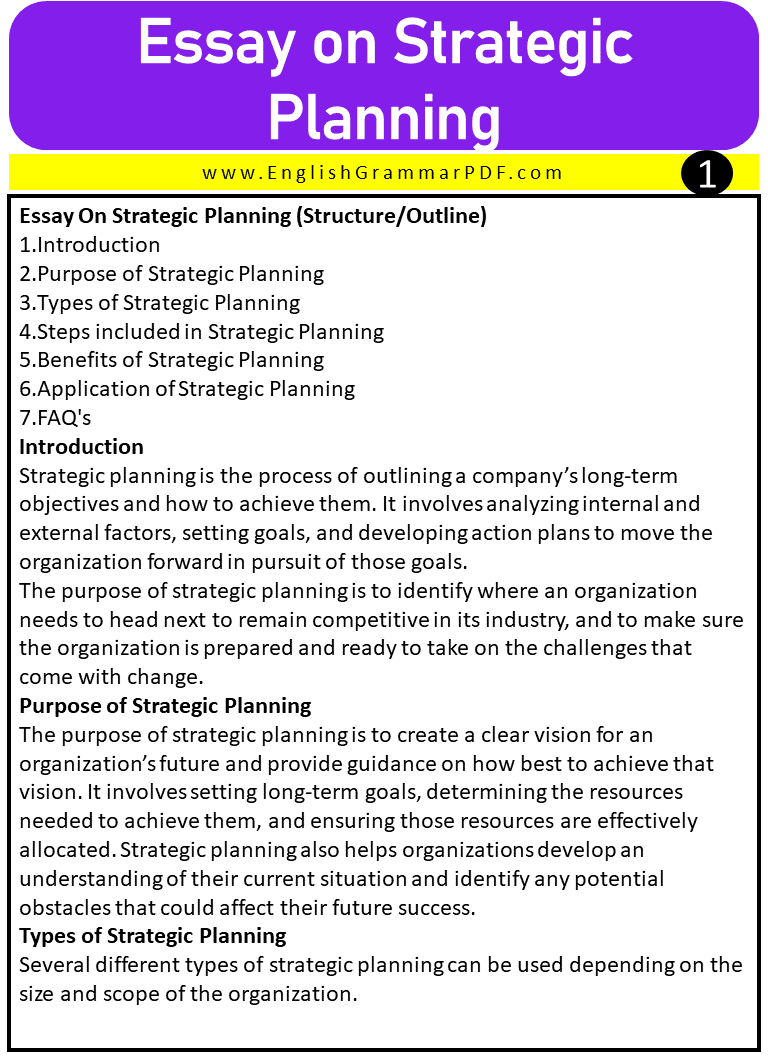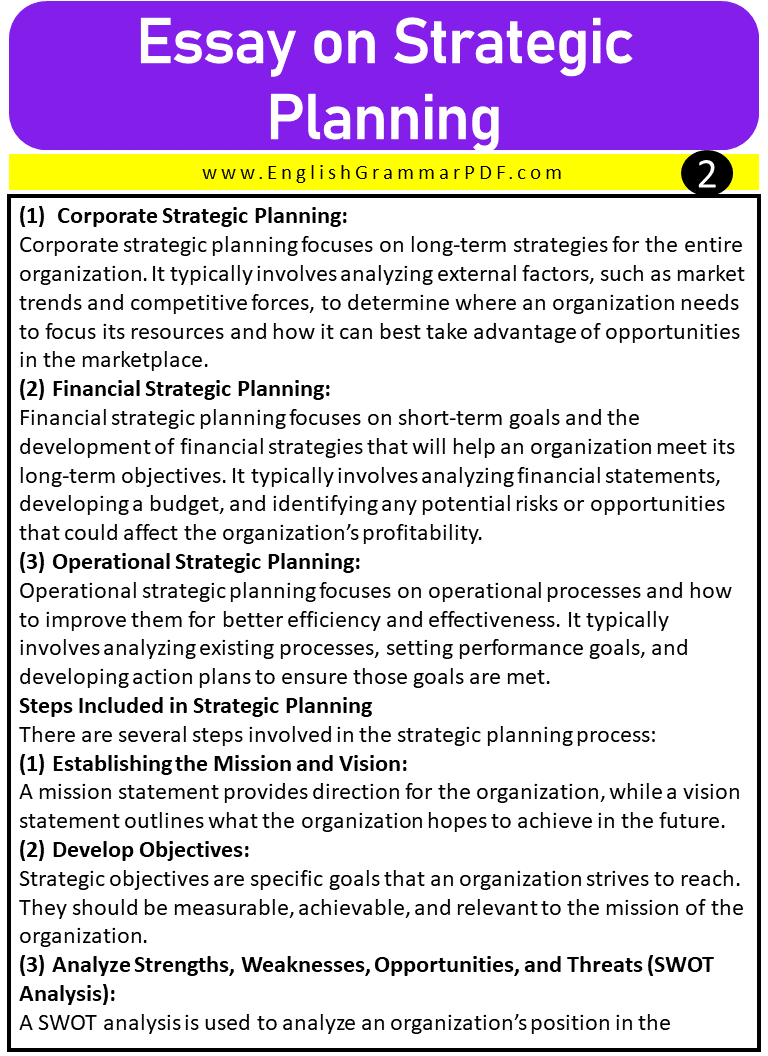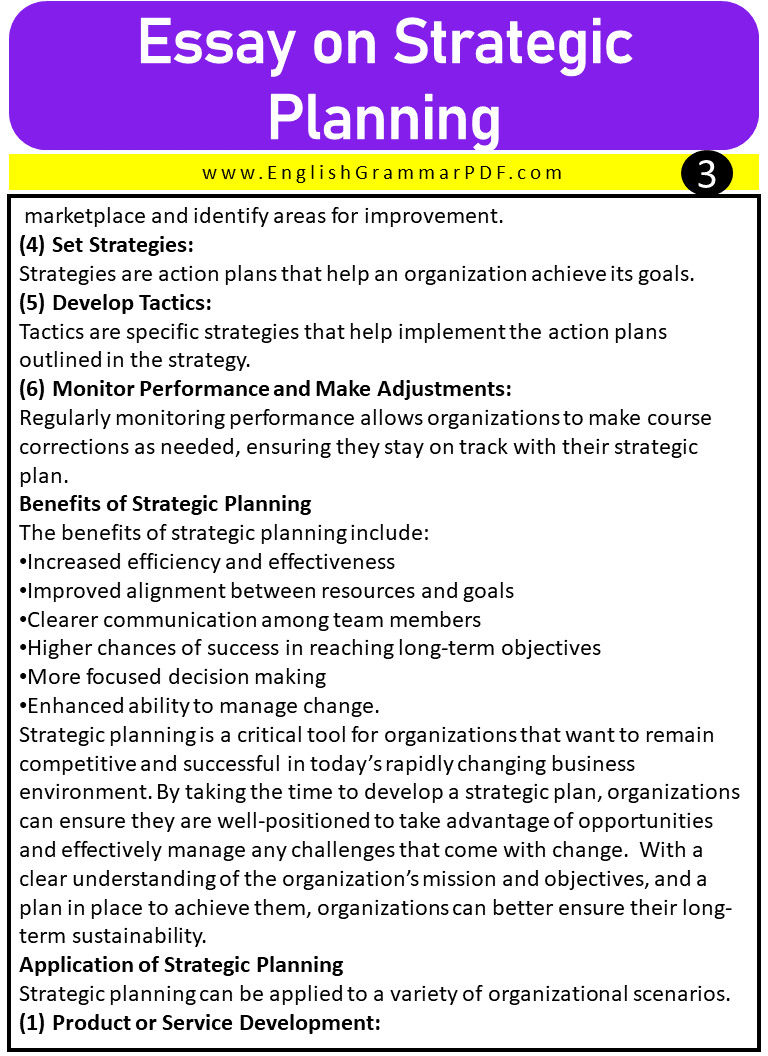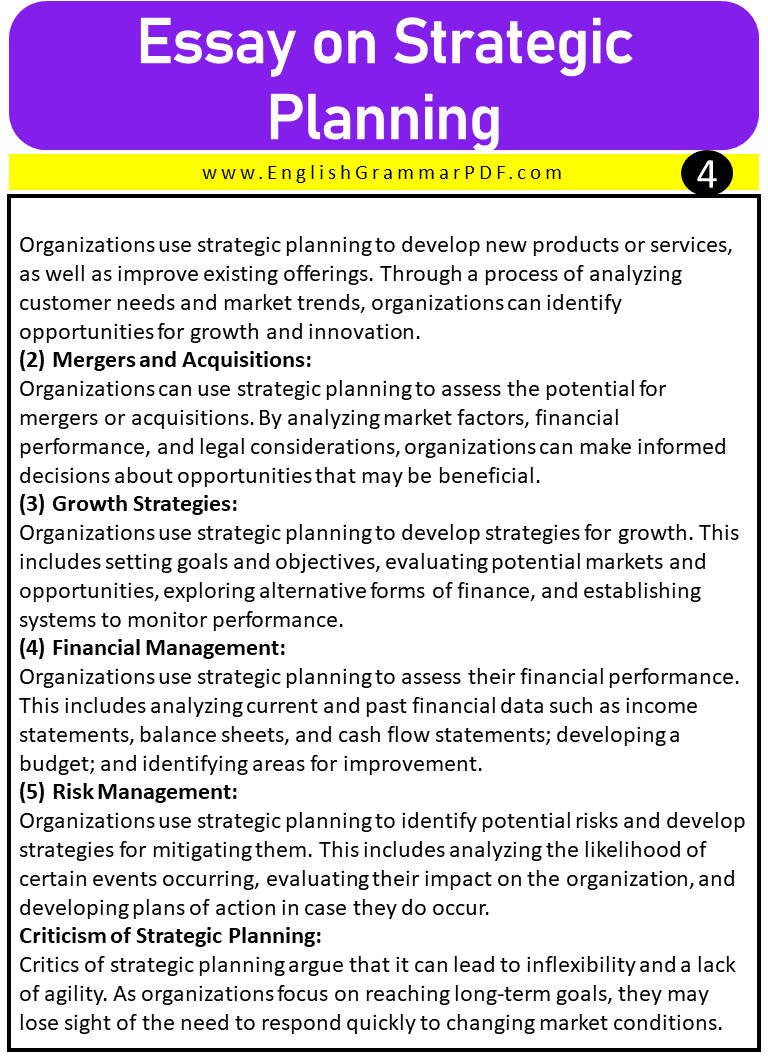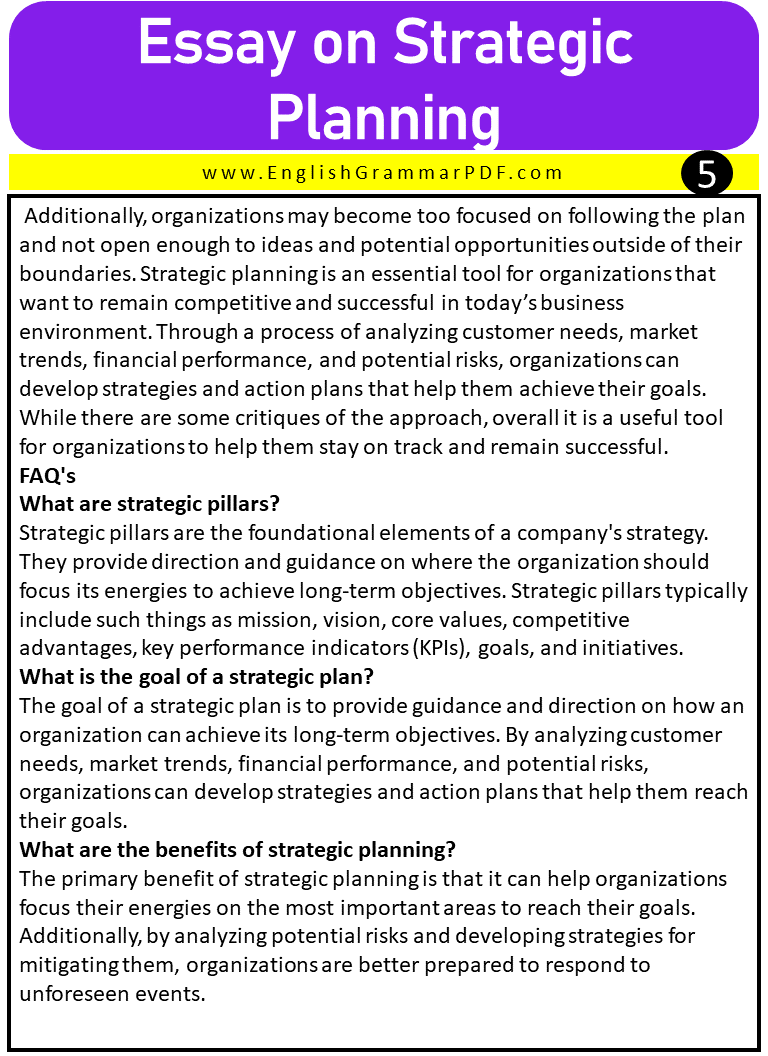Essay On Strategic Planning (Structure/Outline)
- Introduction
- Purpose of Strategic Planning
- Types of Strategic Planning
- Steps included in Strategic Planning
- Benefits of Strategic Planning
- Application of Strategic Planning
- FAQ’s
Introduction
Strategic planning is the process of outlining a company’s long-term objectives and how to achieve them. It involves analyzing internal and external factors, setting goals, and developing action plans to move the organization forward in pursuit of those goals.
The purpose of strategic planning is to identify where an organization needs to head next to remain competitive in its industry, and to make sure the organization is prepared and ready to take on the challenges that come with change.
Purpose of Strategic Planning
The purpose of strategic planning is to create a clear vision for an organization’s future and provide guidance on how best to achieve that vision. It involves setting long-term goals, determining the resources needed to achieve them, and ensuring those resources are effectively allocated. Strategic planning also helps organizations develop an understanding of their current situation and identify any potential obstacles that could affect their future success.
Discover More:
Types of Strategic Planning
Several different types of strategic planning can be used depending on the size and scope of the organization.
(1) Corporate Strategic Planning:
Corporate strategic planning focuses on long-term strategies for the entire organization. It typically involves analyzing external factors, such as market trends and competitive forces, to determine where an organization needs to focus its resources and how it can best take advantage of opportunities in the marketplace.
(2) Financial Strategic Planning:
Financial strategic planning focuses on short-term goals and the development of financial strategies that will help an organization meet its long-term objectives. It typically involves analyzing financial statements, developing a budget, and identifying any potential risks or opportunities that could affect the organization’s profitability.
(3) Operational Strategic Planning:
Operational strategic planning focuses on operational processes and how to improve them for better efficiency and effectiveness. It typically involves analyzing existing processes, setting performance goals, and developing action plans to ensure those goals are met.
Steps Included in Strategic Planning
There are several steps involved in the strategic planning process:
(1) Establishing the Mission and Vision:
A mission statement provides direction for the organization, while a vision statement outlines what the organization hopes to achieve in the future.
(2) Develop Objectives:
Strategic objectives are specific goals that an organization strives to reach. They should be measurable, achievable, and relevant to the mission of the organization.
(3) Analyze Strengths, Weaknesses, Opportunities, and Threats (SWOT Analysis):
A SWOT analysis is used to analyze an organization’s position in the marketplace and identify areas for improvement.
(4) Set Strategies:
Strategies are action plans that help an organization achieve its goals.
(5) Develop Tactics:
Tactics are specific strategies that help implement the action plans outlined in the strategy.
(6) Monitor Performance and Make Adjustments:
Regularly monitoring performance allows organizations to make course corrections as needed, ensuring they stay on track with their strategic plan.
Benefits of Strategic Planning
The benefits of strategic planning include:
- Increased efficiency and effectiveness
- Improved alignment between resources and goals
- Clearer communication among team members
- Higher chances of success in reaching long-term objectives
- More focused decision making
- Enhanced ability to manage change.
Strategic planning is a critical tool for organizations that want to remain competitive and successful in today’s rapidly changing business environment. By taking the time to develop a strategic plan, organizations can ensure they are well-positioned to take advantage of opportunities and effectively manage any challenges that come with change. With a clear understanding of the organization’s mission and objectives, and a plan in place to achieve them, organizations can better ensure their long-term sustainability.
Application of Strategic Planning
Strategic planning can be applied to a variety of organizational scenarios.
(1) Product or Service Development:
Organizations use strategic planning to develop new products or services, as well as improve existing offerings. Through a process of analyzing customer needs and market trends, organizations can identify opportunities for growth and innovation.
(2) Mergers and Acquisitions:
Organizations can use strategic planning to assess the potential for mergers or acquisitions. By analyzing market factors, financial performance, and legal considerations, organizations can make informed decisions about opportunities that may be beneficial.
(3) Growth Strategies:
Organizations use strategic planning to develop strategies for growth. This includes setting goals and objectives, evaluating potential markets and opportunities, exploring alternative forms of finance, and establishing systems to monitor performance.
(4) Financial Management:
Organizations use strategic planning to assess their financial performance. This includes analyzing current and past financial data such as income statements, balance sheets, and cash flow statements; developing a budget; and identifying areas for improvement.
(5) Risk Management:
Organizations use strategic planning to identify potential risks and develop strategies for mitigating them. This includes analyzing the likelihood of certain events occurring, evaluating their impact on the organization, and developing plans of action in case they do occur.
Criticism of Strategic Planning:
Critics of strategic planning argue that it can lead to inflexibility and a lack of agility. As organizations focus on reaching long-term goals, they may lose sight of the need to respond quickly to changing market conditions. Additionally, organizations may become too focused on following the plan and not open enough to ideas and potential opportunities outside of their boundaries.
Strategic planning is an essential tool for organizations that want to remain competitive and successful in today’s business environment. Through a process of analyzing customer needs, market trends, financial performance, and potential risks, organizations can develop strategies and action plans that help them achieve their goals. While there are some critiques of the approach, overall it is a useful tool for organizations to help them stay on track and remain successful.
FAQ’s
What are strategic pillars?
Strategic pillars are the foundational elements of a company’s strategy. They provide direction and guidance on where the organization should focus its energies to achieve long-term objectives. Strategic pillars typically include such things as mission, vision, core values, competitive advantages, key performance indicators (KPIs), goals, and initiatives.
What is the goal of a strategic plan?
The goal of a strategic plan is to provide guidance and direction on how an organization can achieve its long-term objectives. By analyzing customer needs, market trends, financial performance, and potential risks, organizations can develop strategies and action plans that help them reach their goals.
What are the benefits of strategic planning?
The primary benefit of strategic planning is that it can help organizations focus their energies on the most important areas to reach their goals. Additionally, by analyzing potential risks and developing strategies for mitigating them, organizations are better prepared to respond to unforeseen events.
What are the challenges of strategic planning?
Some of the challenges of strategic planning include complexity, inflexibility, and a lack of agility. As organizations focus on reaching long-term goals, they may become too focused on following the plan and not be open enough to ideas and potential opportunities outside of their boundaries.
Essay On Strategic Planning PDF
